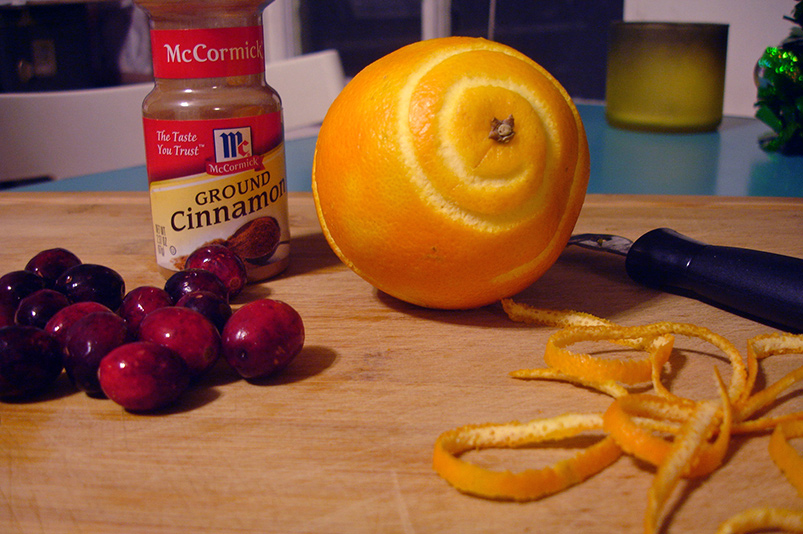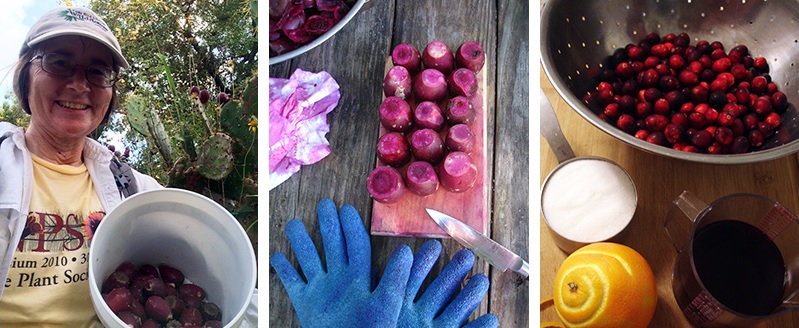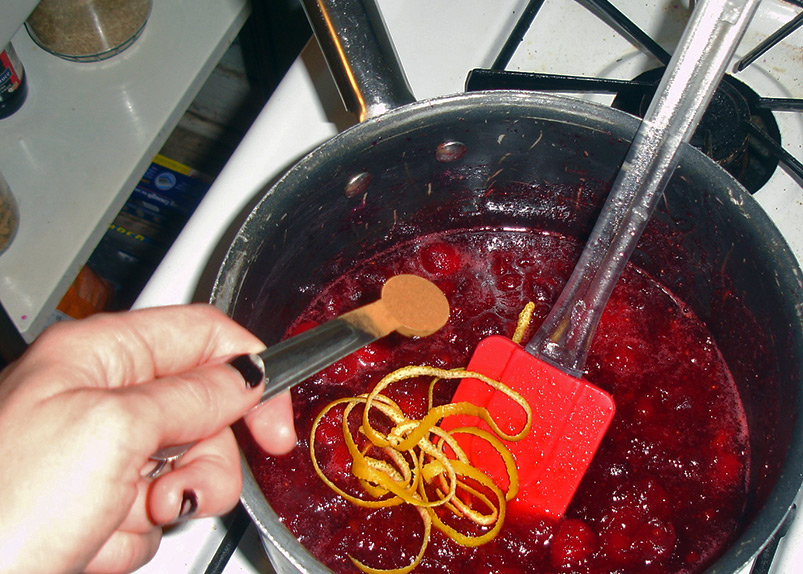Taste of Place: Prickly Pear Cranberry Sauce

Fresh cranberries, cinnamon and orange zest about to meet a Texas native: prickly pear. PHOTO Amy McCullough
THERE ARE A LOT OF WAYS to extract juice from prickly pear fruits (also known as “tunas”). Some folks start with the whole fruit, glochids and all, and boil it in a few inches of water, smashing the softened fruit through sieves upon sieves and finishing with cheesecloth. Others throw scorched fruit (to remove small spines) into a food processor and follow with a similar fine-straining regiment afterward. That all sounded labor-intensive and a bit dangerous to me (plus I don’t have a food mill or a large food processor), so I took a tip from Wildflower Center Plant Conservationist Minnette Marr and went the ultra-safe route, peeling the tunas before getting involved in anything further.
Minnette, who graciously harvested about 50 tunas for me, offered this piece of advice for peeling tunas: “If you end up with glochids in your fingers, do not try to pull them out. The business end is a small fishhook. Just use a pocket knife or razor blade to ‘shave’ off the part that sticks out. The little fishhook is not nearly so bothersome with its long end removed.” Even with my gloves on, I ended up with a few sneaky spines in my fingers, and Minnette’s advice proved invaluable. The peeling itself was quite easy, as the tunas were so ripe they fell right out of their husks.

LEFT Minnette Marr, harvester of prickly pear tunas. CENTER Peeled tunas and a magenta-stained cutting board. RIGHT Cranberries, prickly pear juice and other ingredients await saucification. PHOTOS Amy McCullough
Once I had peeled fruits, I followed the cover-with-a-few-inches-of-water-and-simmer method: I brought the water and tunas to a boil, then simmered them for about 10 minutes before pressing the softened tunas through a larger-mesh strainer (not one I trusted to sort out glochids). I ended up with over four cups of juice when all was said and done (though I did dispose of a few overripe tunas during the peeling process).
Now, at long last, I was ready to make something with this prickly pear juice! Minnette suggested a prickly pear-infused cranberry sauce, and who am I to argue with the person supplying me with 50 prickly pear tunas? I had also volunteered to try my hand at a citrus-chile pequin turkey dish for Thanksgiving, so cranberry sauce was a perfect match.
Prickly Pear-Cranberry Sauce
I followed the most basic recipe out there for fresh cranberry sauce, substituting prickly pear juice for water. Prickly pear juice can also be made into syrup for prickly pear margaritas or lemonade.
INGREDIENTS
- 1 cup granulated sugar
- 1 cup juice from fruit of prickly pear (Opuntia spp.)
- 1 12-ounce package fresh cranberries (Most cultivated cranberry varieties developed from Vaccinium oxycoccos, which is native to North America.)
- Strips of zest from one whole orange (I used one of the oranges from my turkey marinade; long strips make for easy removal after chilling. I suppose you could also mix in a smaller amount of grated zest, but I like the challenge of the spiral.)
- 1/2 teaspoon ground cinnamon
DIRECTIONS
Wash and pick over the cranberries for any oddballs or those you deem unworthy. Give them a rinse in a colander (because that’s the decent thing to do).
Bring prickly pear juice and sugar to a boil, stirring to dissolve sugar.
Add cranberries and return to a boil. I like to squish the cranberries a little as they cook.
Reduce the heat and simmer for about 10 minutes or until all the cranberries have burst. During this portion, beware exploding berries! (Maybe that’s where Ocean Spray got the idea for their name, because these babies were busting and spraying deep pink dots all over my white stove.) I’d recommend placing a lid loosely over the pot as a shield and/or wearing an apron. It’s also not a bad idea to be on the lookout with a sponge for quick cleanup. It was a bit warm in my kitchen in the midst of this, so I skipped the apron but took a tip from nature and camouflaged myself in a burgundy T-shirt.
Take off the heat and mix in the orange zest and cinnamon. I saw a lot of ideas for cranberry sauce mix-ins while reading recipes on the internet, but this combo turned out nicely and had a very “holiday” scent to it. In fact, take a moment to smell it while it’s still warm and emanating that fragrant orange-and-cinnamon holiday magic.

Adding the holiday magic, i.e., cinnamon and orange zest. PHOTO Amy McCullough
Remove from heat. Cool at room temperature and then chill in refrigerator for a few hours (I let mine sit a whole work day). The sauce will thicken as it cools. Remove orange zest before serving.
I wondered if this would taste just like regular cranberry sauce, and it did not! It had a pleasant earthiness to it and a special “something” … that was most likely the prickly pear juice.
MAKES ABOUT TWO AND A HALF CUPS
Recipe adapted from Culinary Adventures with Camilla and HGTV.com.
Related Stories:
Chile Pequin-Citrus Turkey
Vegan Wild Onion and Tuber Stew
Spiced Pecans
Wild Onion and Chile Pequin Cornbread
Prickly Pear Margaritas
Persimmon Dessert Bars
Chile Pequin Vinegar

